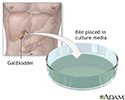Bile culture
Culture - bile
Bile culture is a laboratory test to detect disease-causing germs in the biliary system.
How the Test is Performed
A sample of bile is needed. This can be done using different methods, including gallbladder surgery or a procedure called endoscopic retrograde cholangiopancreatography ( ERCP ).
Bile
Bile is a fluid that is made and released by the liver and stored in the gallbladder. Bile helps with digestion. It breaks down fats into fatty acid...

Gallbladder surgery
Open gallbladder removal is surgery to remove the gallbladder through a large cut in your abdomen.

ERCP
ERCP is short for endoscopic retrograde cholangiopancreatography. It is a procedure that looks at the bile ducts. It is done through an endoscope. ...

The bile sample is sent to a lab. There, it is placed in a special dish called a culture medium to see if bacteria, viruses, or fungi grow on the sample.
How to Prepare for the Test
Preparation depends on the specific method used to obtain the bile sample. Follow your health care provider's instructions exactly.
How the Test will Feel
If bile is taken during gallbladder surgery, you will feel no pain because you are asleep.
If bile is taken during ERCP, you will receive medicine to relax you. You may have some discomfort as the endoscope passes through your mouth, throat, and down the esophagus. This feeling will go away shortly. You may also be given medicine (anesthesia) so that you will sleep lightly for this test. If you are asleep, you will not feel any discomfort.
Endoscope
An endoscope is a medical device with a light attached. It is used to look inside a body cavity or organ. The scope is inserted through a natural o...
Why the Test is Performed
This test is done to detect infection within the biliary system . The biliary system creates, moves, stores, and releases bile to help in digestion.
Biliary system
The biliary system creates, moves, stores, and releases bile into the duodenum. This helps the body digest food. It also assists in transporting wa...

Normal Results
The test result is normal if no bacteria, virus, or fungus grew in the laboratory dish.
Note: Normal value ranges may vary slightly among different laboratories. Talk to your doctor about the meaning of your specific test results.
What Abnormal Results Mean
An abnormal result means bacteria, fungus, or a virus grew in the laboratory dish. This may be a sign of infection.
Risks
Risks depend on the method used to take a sample of the bile. Your health care provider can explain these risks.
References
Hall GS, Woods GL. Medical bacteriology. In: McPherson RA, Pincus MR, eds. Henry's Clinical Diagnosis and Management by Laboratory Methods . 22nd ed. Philadelphia, PA: Elsevier Saunders; 2011:chap 57.
Kim AY, Chung RT. Bacterial, parasitic, and fungal infections of the liver, including liver abscess. In: Feldman M, Friedman LS, Brandt LJ, eds. Sleisenger and Fordtran's Gastrointestinal and Liver Disease Pathophysiology/Diagnosis/Management . 10th ed. Philadelphia, PA: Elsevier Saunders; 2016:chap 84.
-
Bile culture - illustration
A bile culture test is performed to see if there is infection in the biliary tract. A specimen of bile is placed in culture media and observed for growth of microorganisms. If there is no growth in the culture, then there is no infection. If there is growth in the culture media, the growth is then isolated and identified to determine the appropriate method of treatment.
Bile culture
illustration
-
Bile culture - illustration
A bile culture test is performed to see if there is infection in the biliary tract. A specimen of bile is placed in culture media and observed for growth of microorganisms. If there is no growth in the culture, then there is no infection. If there is growth in the culture media, the growth is then isolated and identified to determine the appropriate method of treatment.
Bile culture
illustration
Review Date: 8/14/2015
Reviewed By: Subodh K. Lal, MD, gastroenterologist at Gastrointestinal Specialists of Georgia, Austell, GA. Review provided by VeriMed Healthcare Network. Also reviewed by David Zieve, MD, MHA, Isla Ogilvie, PhD, and the A.D.A.M. Editorial team.

